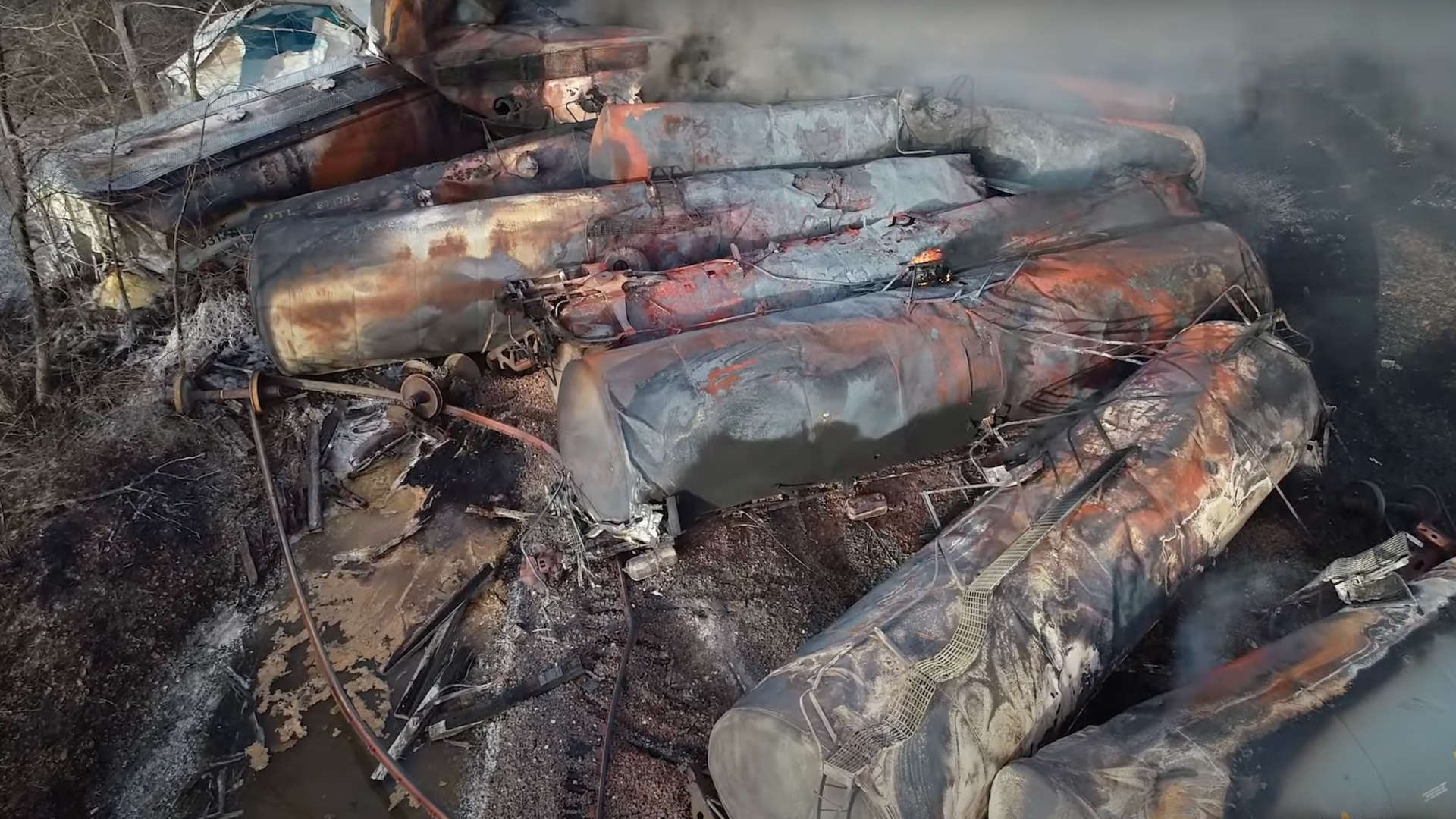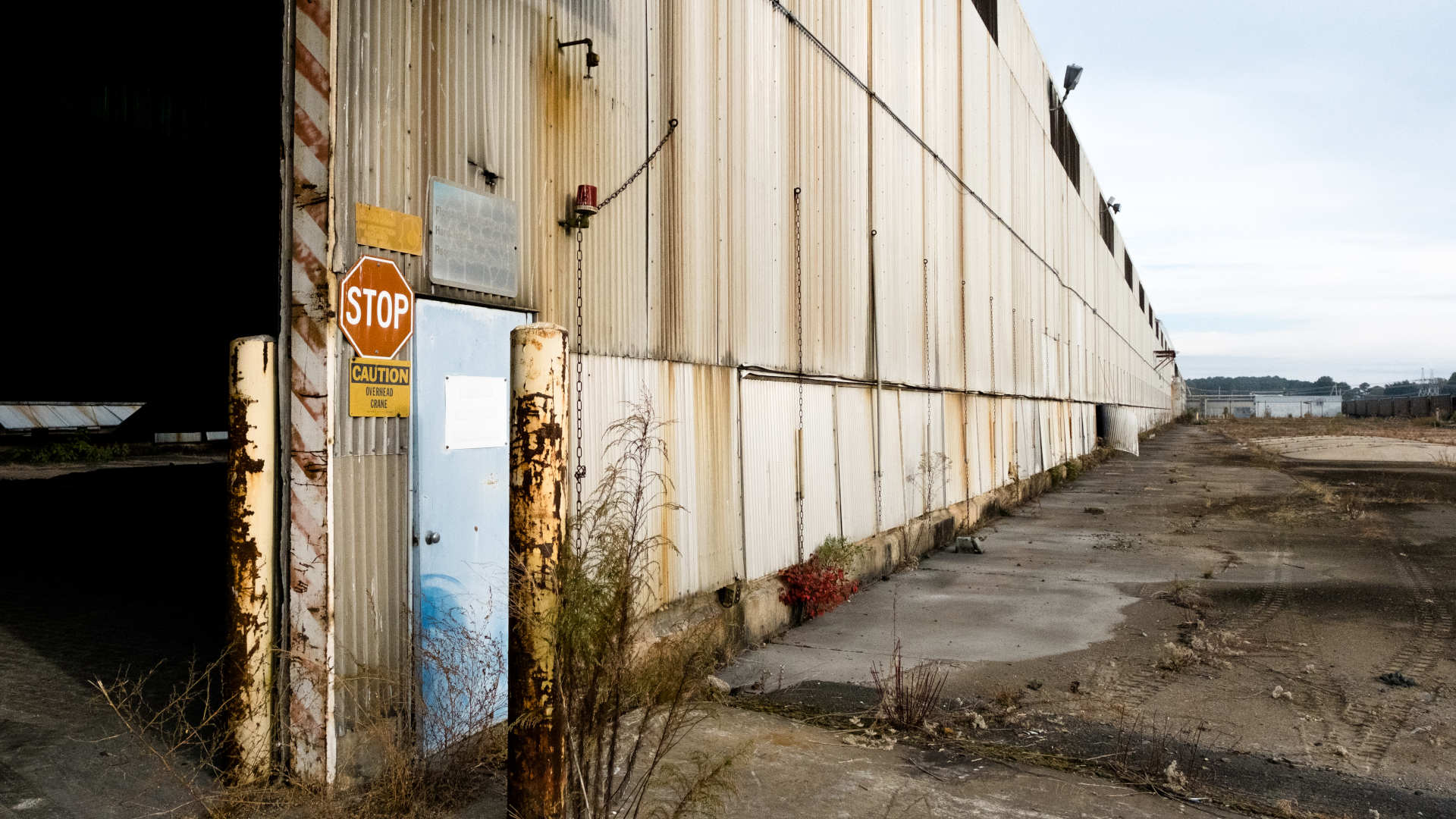The Environmental and Health Fallout of Rural Train Derailments
As waste from the Norfolk Southern train derailment in East Palestine, Ohio, is hauled out to different parts of the country, residents say worries loom about long-term mental health issues, the town’s economic stability, and the safety of the air and water.
“It’s scary,” said Cortney Wischerman, 50, a lifelong resident of East Palestine, a town with a population of fewer than 5,000. “There is a lot of anger because there are so many questions and no answers.”
This story was originally published by Inside Climate News and is reproduced here as part of the Climate Desk collaboration.
Wischerman said the thought of the trains causing a disaster in her hometown hadn’t crossed her mind until it actually happened on the night of Feb. 3. After the incident, she said she could smell the stench from the derailment and had a headache the days before responders burned off the chemicals. “It felt like it was burning my nose.”
Thirty-eight of the 141 train cars that derailed in East Palestine carried volatile chemicals. Among them was vinyl chloride, a known human carcinogen, which is used to make polyvinyl chloride plastic and vinyl products. The catastrophic derailment was followed by responders burning off the vinyl chloride to avoid an explosion, a temporary order for nearby residents to evacuate, reports of headaches and nausea from residents, and some 3,500 fish dying in waterways near the derailment. A preliminary report by the National Transportation Safety Board partially attributed the derailment to a wheel bearing being overheated.
For Wischerman, a breast cancer survivor, seeing trains travel through East Palestine brings up constant fears of getting cancer again. “It’s awful to see,” she said. “I don’t want to relive that.”
She and her family also worry about the working-class town’s ability to rebound from an economic hit quickly. Some residents are considering moving out of the village to escape possible health risks, but other homeowners fret about being able to sell their homes after the disaster.
“People won’t want to come into town,” said Kristopher Wischerman, Wischerman’s husband. He expects the value of his property to go down.
His concerns are not unfounded, said Anne Junod, a senior research associate at the Urban Institute who studies train derailments.
“When you see property values go down, you see economic development activity go down on top of all the social disruption that this is going to be causing for years,” said Junod.
Train derailments overwhelmingly happen in rural and tribal areas where communities have fewer resources for response and recovery, Junod said. There are more than 140,000 miles of railway in the U.S., and over 100,000 of them run through rural areas. Just a month after the East Palestine derailment, another Norfolk Southern train derailed in Ohio, though it was not carrying hazardous materials.
Junod’s research on train derailments shows that residents in rural towns like East Palestine, located in a hub of oil, gas, and freight transportation development, usually bear the economic and social burden on top of the environmental and health threats of such catastrophes.
Mounting uncertainties after disasters like the one in East Palestine commonly spark mistrust and tensions, said Junod.
Disasters “can exacerbate social divisions about decision-making and priorities,” she said. “We see that in every community that has had a disaster like this.”
Much like in natural disasters, the road to recovery is long for the communities impacted by these sorts of disasters, Junod added. The constant concern about an accident like this happening again, that residents’ health will take a hit, and that the community’s economic well-being will tank are common concerns she has heard from communities where train derailments have occurred.
Immediate concerns were about municipal water and air quality, but now residents are considering what longer-term implications might be, said Nick Messenger, a researcher at the Ohio River Valley Institute who has been studying the East Palestine derailment. Disasters like these create an ongoing ripple effect on the local economy, he said.
“People don’t travel, they don’t vacation, they don’t purchase property for a period of time after these things occur,” said Messenger. “The costs to the people in his town after this disaster are going to continue to play out and evolve over not just years, but probably decades.”
Chaney Nezbeth, Wischerman’s sister and the executive director of The Way Station, a faith-based organization that has been coordinating donations from all over the country toward affected residents in East Palestine, is plotting out both a short- and long-term recovery.
“First order of business is making sure they feel safe in their home and that they have those doctor’s appointments in place,” said Nezbeth. She said the next step in their efforts to support the community of East Palestine is to continue raising funds to address the impacts on residents’ mental health from the incident and then on property values and on how they can remarket the town.
“There is a psychological toll residents face from having been in close proximity to a catastrophic event of this kind, having to address the immediate impacts and fearing how it will continue to affect them,” said Nezbeth.
According to a 2019 study, the psychological effects of disasters, including industrial disasters, are more drastic among children, women, and the dependent elderly population.
While derailments are frequent, they have decreased in recent years. More than 1,000 happened in 2021, the fewest in over three decades. Still, they have become more severe as the average train lengths have grown with fewer personnel per car, Vox reported.
While railroads are largely regulated at the federal level, Junod found that additional regulations, like reduced speed limits, are overwhelmingly established in mid- to large-size cities, exposing smaller communities to more disaster risks, which can change how locals, generally accustomed to the rhythms of the trains, view the railroads.
“What we see is that in more rural, smaller communities where the railroad is truly just part of the community in a way that’s much more intimate for folks, everybody knows when the trains come in, and it’s just very much a part of the community infrastructure,” said Junod.
In 2016, a train derailed in Mosier, Oregon, a town with a population of less than 500, spilling more than 40,000 gallons of oil and contaminated soil and groundwater.
Advocacy from tribal members, residents, and environmentalists in Columbia River Gorge led to a statewide rule in 2019 aimed at reducing railroad disasters in Oregon. The new rule included requiring railroad companies to develop plans to respond to oil and hazardous material spills, provide the state with proof of enough insurance to pay for the response and cleanup and require notification when passing freight trains will be carrying large amounts of oil or hazardous materials.
Kevin Gorman, who leads Friends of the Columbia Gorge, a nonprofit organization that pushed for protection from freight train derailments, said the incident seven years ago has made them more discerning of railroad activity in the area.
“The rose-colored glasses are not on anymore,” he said. “I think [seeing the train] just psychologically wears at people, and sometimes they might not even be able to know what the impact is because it’s just so ever-present.”
Ohio Gov. Mike DeWine, a Republican, told residents days after the derailment that the water is safe to drink and to return home as they continue to monitor air quality and screen homes.
Still, Wischermanand her family, including her miniature pitbull, Bella, only drink bottled water, most of which has been gifted from numerous donations made to her community from all over the country. Many others in town are still doing the same, questioning the validity of testing by the federal government and Norfolk Southern, the company whose train derailed, which has conducted more than 575 in-home air monitoring tests. Some residents are even paying out of pocket for their own testing, the New York Times reported.
More than a dozen lawsuits have been filed by residents over the train derailment since the disaster occurred.
The U.S. Environmental Protection Agency ordered Norfolk to cover all the costs associated with cleaning up the derailment. DeWine called on the company to create a fund to cover medical expenses for victims. Norfolk Southern said it has committed more than $21 million to East Palestine on top of cleanup costs, including more than $7 million in direct payments to citizens impacted by the incident — roughly $1,400 per resident in a town of around 5,000 — and $1 million for community needs and improvements.
But social and psychological impacts from these types of disasters are not usually factored into the cost companies become responsible for, and the community ends up paying for it, said Junod.
Communities “say they’re left really holding the bag for most of the environmental costs,” she said, “but the social and economic costs in the long term as well.”
Aydali Campa covers environmental justice at Inside Climate News.











